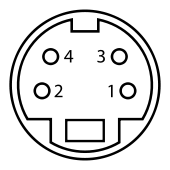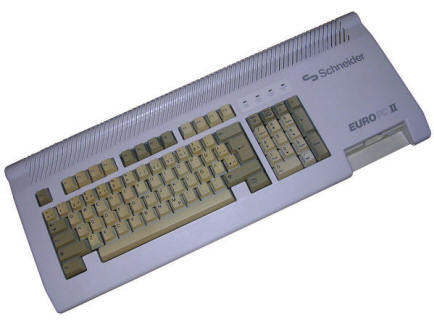Schneider Euro PC II
After successes with microcomputers, many computer
companies released PC compatible computers. But PC was an office
computer, and even adding CGA graphics to it didn't changed the fact
that PC was a big box on desk, usually with external keyboard and
dedicated monitor. After IBM released PCjr, and quickly took it from the
market, companies tried to make PC a new home computer. Commodore
released a small PC-1, Vendex released Explorer, and Amstrad had a very
good sales of their PC - PC1512. In Germany, Schneider Computer
Division, which was selling Amstrad products, decided to offer a "home
PC" as a continuation of Amstrad CPC Z80-powered microcomputers line. In
1988 they released Euro PC, and not much later Euro PC II (with new
mainboard and 768kB of RAM) which were a complete PC clones in a
keyboard-like casings. Quickly Euro PC became a popular product offered
even in mail-order catalogues. Euro PC is a totally German machine not
much related to British Amstrad.
Euro PC II was a 8088-based complete PC XT-compatible computer
containing a CGA/MDA-compatible graphics chip and 768kB of RAM. In the
same casing there was a keyboard and 720kB 3.5" floppy disk drive. By
using connectors it was possible to connect joystick, mouse, external
floppy disk drive or hard disk using XTA interface. The processor could
run at 9.54MHz which was similar to many XTs of late 1980s. In mainboard
there was a battery-backed clock chip, so the time was preserved. Single
ISA slot allows to expand its capabilities by installing interface or
VGA boards. It was usually purchased by consumers as a "startin point"
in PC environment. It was shipped with power supply unit, 12-inch
display and MS-DOS 3.3 operating system with MS Works package. It was
more than enough to start with PC.
Continuing this line, Schneider manufactured more PC-like computers like Euro XT, Euro AT, Euro SX or Tower AT with vertical floppy disk slots.
| Manufacturer | Schneider | |
| Origin | Germany | |
| Year of unit | 1989 | |
| Year of introduction | 1988 | |
| Class | XT | |
| CPU | Intel 8088 | |
| Speed | 9.54MHz | |
| RAM | 768kB (640+128) | |
| ROM | Schneider PC BIOS | |
| Graphics | CGA/Hercules compatible | |
| Sound | PC Speaker | |
| System expansion bus | 1 8-bit ISA slot for short board | |
| Floppy/removable media drives | 1x 3.5" 720kB Possible to connect external floppy disk drive. |
|
| Hard disk: | None, external XTA interface | |
|
Peripherals in collection: |
||
| Other boards:
|
None | |
| Non-standard expansions: | Possible to install external FDD or HDD. | |
| Operating system(s): | MS-DOS 3.3 |
My unit was from e-waste in Germany. The mainboard was in really poor condition and was not booting up. I found that RTC battery leaked destroying tracks in PCB and one 74-line bus driving circuit. The mainboard has been cleaned and tracks restored. After removing battery, it was replaced with CR2032. Another problem was disk drive which was totally destroyed by humidity. It was replaced according to this hack. Now the unit starts up and can boot from floppy disk.
| Contents: | Starting, usage | Pinouts | Links |
Starting
The computer boots BIOS and performs power-on test. To enter setup, use Ctrl-Alt-Esc combination at startup. Then it boots from floppy, or, if XTA hard disk is connected, it will try to boot from it.
But the most important thing: If you got a new Euro PC, doesn't matter is it working or not, open it and REMOVE THE BATTERY. If it is already removed, check tracks nearby, maybe they need cleaning. Do not install a new rechargeable battery of the same type, because in 5 years you will get the same problem. Just solder a diode there (cathode facing battery +) and use CR2032 as it will not leak so easily. All EuroPCs I've seen have problems with leaking batteries as it is harder to open them than desktop.
The computer has BIOS setup which allows to set all configuration parameters without touching any jumper.
Power supply unit (only Euro PC II - the first one has other DIN socket):

2,4 - ca. 19V, 1-2A, unregulated
1,3 - GND
All voltages are regulated from this on mainboard.
Mouse / joystick:

1 - Xb / UP
2 - Xa / DOWN
3 - Ya / LEFT
4 - Yb / RIGHT
5 - Middle button / JOY1_Select (to GND)
6 - Left button / JOY2_Select (to GND)
7 - Vcc
8 - GND
9 - Right button / FIRE
Serial/parallel ports are standard, as for XT.
External floppy drive connector (for drive B):

1. /INDEX
2. /MOTORA (not for ext. drive!)
3. /DSEL
4. /DSELA (not for external drive!)
5. /MOTOR
6. /DIR
7. /STEP
8. /WDATA
9. /WGATE
10. /TRK0
11. /WPROT
12. /RDATA
13. /SIDE1
14-16. +5V DC
17. NC
18. PWRON*
19-25. GND
* PWRON - Short to ground to turn the computer on. Used when FDD/HDD has
external power supply unit and computer needs all devices to be started
first.
WARNING: I've seen a model in which wires were crimped different way on
connector. Check 5V/GND connections with ohmmeter before connecting
anything. What works in my unit, may not work in yours.
More pinouts, like XTA hard disk pinout, can be found in technical description in fileland.
http://oldmachinery.blogspot.com/2013/03/schneider-europc.html - In
collection
http://www.spacereh.de/hc/ams/scheuropc.htm - Another collection
entry
Service manuals, BIOSes and many other things were available in
ftp://ftp.cpcszene.de, but it
seems to be down. If it is still down, the mirror is here:
https://archive.org/details/ftp-cpcszene-de. Or use fileland for the
most essential documents in compressed versions..





